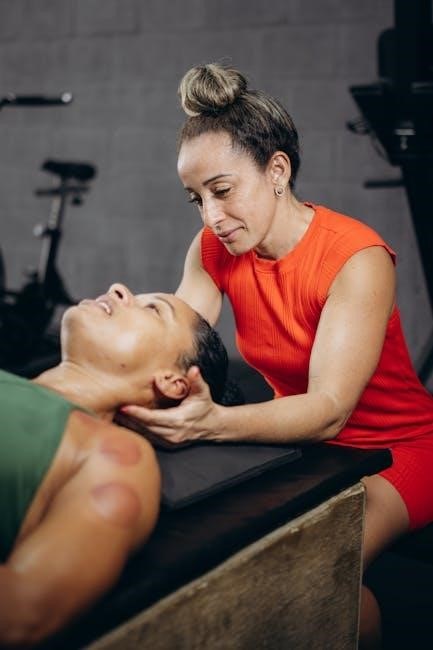Rotator cuff physical therapy exercises are essential for recovery, with
- step-by-step guides
and videos available online to help patients understand the process and perform exercises correctly at home with minimal equipment and supervision from a doctor or therapist always.

Understanding the Importance of Rehabilitation
Rehabilitation plays a crucial role in the recovery process of rotator cuff injuries, and it is essential to understand its importance to ensure a successful outcome. The primary goal of rehabilitation is to restore strength, flexibility, and function to the affected shoulder, allowing patients to return to their normal activities without pain or discomfort. A well-structured rehabilitation program can help prevent further injury, reduce pain and inflammation, and promote healing. It is a gradual process that requires patience, dedication, and adherence to a customized exercise program. By committing to a rehabilitation program, patients can expect to see significant improvements in their range of motion, strength, and overall function, ultimately leading to a full recovery. The rehabilitation process typically involves a combination of physical therapy exercises, stretching, and strengthening activities, all of which are designed to target the specific needs of the patient. With the right approach and mindset, patients can overcome their rotator cuff injuries and regain optimal shoulder function. Rehabilitation is a critical component of treatment, and its importance cannot be overstated. A proper rehabilitation program can make all the difference in the recovery process.

Typical Rehabilitation Exercises
Exercises include
- stretching
and strengthening activities to improve shoulder function and reduce pain with a doctor’s supervision always.
Examples of Exercises for Rotator Cuff Injuries
There are various exercises that can help with rotator cuff injuries, including those that target the muscles of the shoulder and scapula. A physical therapist can provide a personalized exercise program, which may include activities such as shoulder flexion, extension, and rotation. Exercises can be performed using
- therabands
or light free weights, and may involve movements such as arm circles and shoulder blade squeezes. It is essential to start slowly and gradually increase the intensity and duration of exercises to avoid exacerbating the injury. A doctor or physical therapist can provide guidance on proper technique and help patients progress through the exercises. Additionally, exercises can be modified to accommodate different levels of ability and mobility. By incorporating exercises into their daily routine, individuals with rotator cuff injuries can improve their range of motion, reduce pain, and enhance overall shoulder function. Regular exercise can also help prevent future injuries and promote long-term recovery. With patience and consistent practice, individuals can regain strength and mobility in their shoulder.

Rotator Cuff and Scapular Strengthening
Exercises using
- therabands
and free weights help strengthen muscles, improving shoulder stability and function with regular practice and supervision from a doctor or therapist always.
Using Therabands and Free Weights
Therabands and free weights are essential tools for rotator cuff and scapular strengthening exercises. These exercises can be done at home with minimal equipment and supervision from a doctor or therapist. The use of therabands provides resistance to help strengthen the muscles, improving shoulder stability and function. Free weights, such as dumbbells, can also be used to add variety to the exercises and target specific muscle groups. It is important to start with light weights and gradually increase the weight as the muscles become stronger. A physical therapist can provide guidance on the proper use of therabands and free weights, as well as demonstrate the exercises to ensure they are being done correctly. With regular practice and dedication, patients can improve their shoulder function and reduce pain and discomfort. By incorporating therabands and free weights into their exercise routine, patients can take an active role in their rehabilitation and recovery. This can help them to return to their normal activities and improve their overall quality of life. Regular exercise can also help to prevent future injuries and reduce the risk of further complications.

Isometric Shoulder External Rotation
Isometric shoulder external rotation exercises involve standing in a doorway with elbow bent and wrist pressing against the door frame, trying to press hand outward into the frame, holding for seconds, with sets repeated daily for therapy.
Performing the Exercise Correctly
To perform the isometric shoulder external rotation exercise correctly, it is essential to stand in a doorway with your elbow bent at a 90-degree angle and the back of your wrist pressing against the door frame. Your doctor or physical therapist will provide guidance on how to do the exercise properly. You should try to press your hand outward into the door frame, holding for 5 seconds, and then release. It is crucial to repeat the exercise for the recommended number of sets, usually 3 sets of 10, to achieve the best results. Additionally, it is vital to focus on proper posture and engage your core muscles to maintain stability and prevent injury. By following these steps and performing the exercise correctly, you can help strengthen your shoulder muscles and improve your overall range of motion. Your physical therapist may also provide modifications or adjustments to the exercise based on your individual needs and progress. Regular practice and patience are key to achieving success with this exercise and overall rehabilitation.
